I became interested in owning a system camera two years ago. A system camera is one of those cool, boxy cameras that can be adapted to any style of photography. After seeing all the Hasselblads and others out of my price range, I became interested in the Bronica ETRS lineup. First off, these are 645 cameras, meaning they take 15 images per roll instead of the 12 on a 6×6 camera, or 9 on a 67. Getting those extra shots per roll makes a big difference when you’re shooting a wedding. 3 extra images per roll doesn’t sound like a lot, but the extra real estate on the 6×6 format is something that I don’t really ever use since I have to crop when printing anyways.
The next reason I was interested in the Bronica is because I could get this camera with three lenses for less than half the cost of a Hasselblad 500cm body. I thought if the build quality and lenses held up, then this camera would be the best bargain camera on the market. And I have to say, this camera has been nothing short of fantastic.
I’ve used this camera for many photoshoots and have achieved some brilliant results from it. And it’s just as good for landscapes as it is for portraits, thanks to its lightweight compared to similar cameras, and tack-sharp lenses.
For portrait photographers, this camera also features a leaf shutter which can be synced with a flash at all speeds! It’s amazing to be able to shoot a portrait at 1/500 of a second and f/2.8 on a film camera — a feature virtually unheard of until high-speed sync became available on digital cameras.
| Skip to Image Gallery | Which Bronica is best | What type of Battery do I need? | Find a Bronica ETRS on eBay
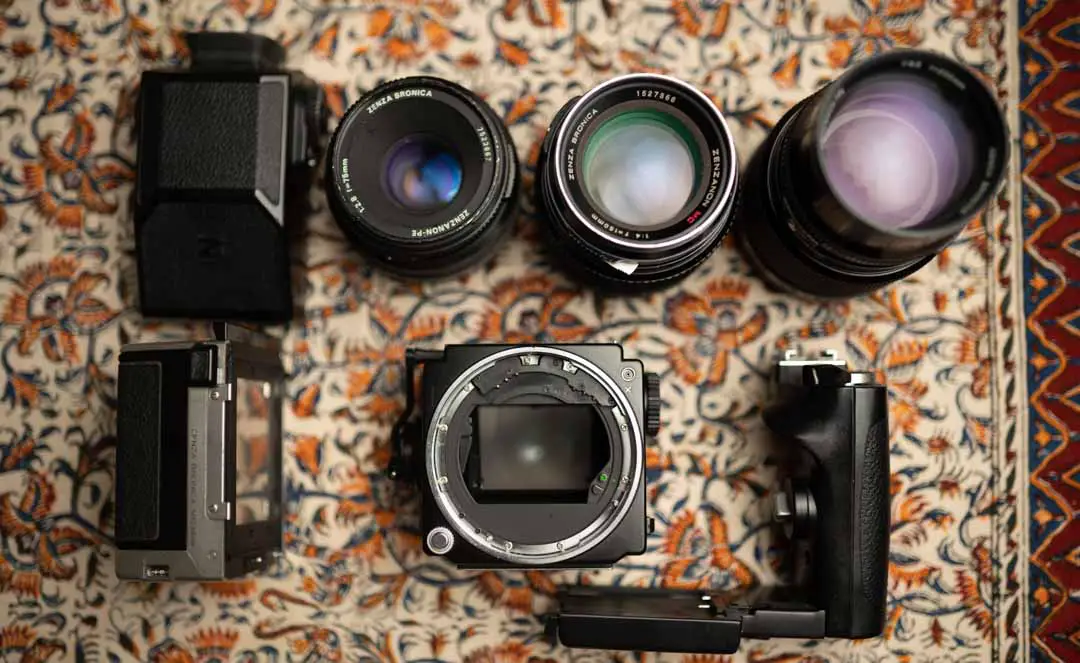
Pros and Cons of the Zenza Bronica ETRS and ETRSi, A.K.A, ‘The Poor Man’s Hasselblad’
This camera has been my go to every time I’ve needed a bit more image quality. It has nearly everything you could want in a system camera at a fraction the cost of the more popular versions. Having multiple backs means that it’s easy to switch between film stocks. If you’re shooting Portra, but find the perfect place for an artsy B&W shot, you can simply switch to a different back pre-loaded with a roll of HP5 and get the shot. As a portrait photographer, that feature has been a godsend.
Below is my honest review of using this camera for two years. I’ve put it through its paces, and have found some places where this camera really shines, and some others where I just needed a different solution. Let’s start with the Pros and Cons.
| Pros | Cons |
| Best deal in medium format System Cameras | Later versions are plasticy |
| Sharp lenses | Can only shoot at 1/500th without a battery |
| Common battery | Bulb and mirror lockup only available on ETRSi |
| 645 means more frames per roll of 120 film | The maximum shutter speed is 1/500th |
| Lightweight, easy to handle | If the electronics fail, the camera is unrepairable |
| Adjustable to your needs | |
| Leaf shutter allows flash sync at all speeds |
What’s the difference between the Bronica ETR, ETRS, and ETRSi?
The Bronica ETR was the company’s first camera that used a leaf shutter built in the lens. The camera was a good place to start, but many of the later versions have some pretty significant advantages. If you just want a basic camera without fancy additions like a lightmeter, mirror lockup, or bulb mode, the ETR will be perfect. This camera features minimal electronics, which means there’s very little to go wrong. If you read my article about Reveni Labs making the newest spot meter on the market, you’ll know a bit more about what can go wrong with film camera electronics.
The ETR line was initially launched in 1976, and went through three major releases, the ETR, ETRS, and ETRSi. There are also variations that didn’t contain the removable back, called the ETR-C.
The major difference between the ETR, and later models like the ETRS and ETRSi, is that the newer cameras feature more advanced electronics and features. The ETRS and ETRSi can both use the Auto Exposure, or AE meters, which have a built-in light meter that can automatically adjust shutter speed based on the reading.
However, there are a couple of advanced features in the ETRSi that made it particularly useful for landscape photography, including a mirror lockup feature and bulb mode for exposures longer than 8s. The ETRSi is also the only version that allows TTL metering when using flash, which can be particularly useful for portrait photographers. The downside of the ETRSi is that it feels plasticy compared to older versions, which were made with more metal parts.
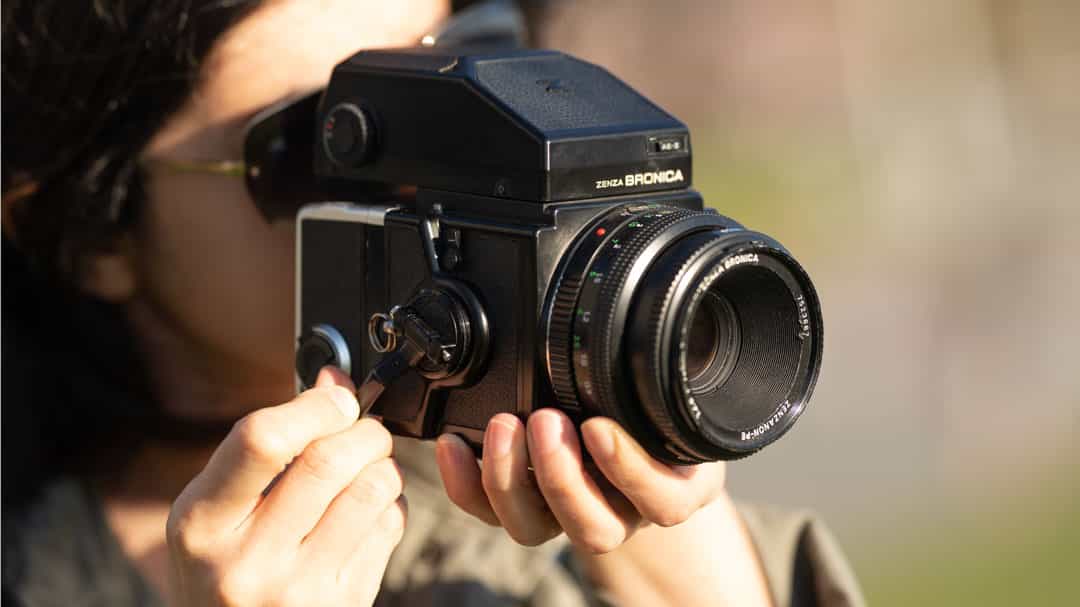
Which version of the Bronica ETR series is best for me?
All three cameras can use the same lenses, handles, viewfinders, and film backs. But any electronic features will only be usable on the later models. If you’re a photographer looking to use cameras that are as electronic-free as possible, the ETR is the best bet. But for those looking to use the camera for flash portraits and landscapes, the ETRSi is the best choice.
I personally don’t recommend the ‘C’ models at this time. The inability to use film backs and switch film mid-roll is a major drawback on these cameras. And at this time, the C versions aren’t significantly cheaper than the non-C versions, so I can’t recommend them at this time.
But no matter which camera you go for, most of the fun is in modulating the Bronicas to fit your needs. Mine came with both a speed grip with the hot shoe flash holder, a camera back, and the AEII viewfinder with the built-in light meter. I took off the speed grip to save a bit of weight and space in my camera bag. And personally, I’ve found it a joy to use the hand crank instead of the speed grip. Holding the camera with two hands feels more natural to me than with the grip. Others will definitely disagree.
But I believe my next purchase for this camera will be the waist-level viewfinder. I find myself often using this camera low to the ground, and would have a much easier time focusing looking down rather than awkwardly laying on the ground using the viewfinder. The only reason I haven’t switched that out yet is because a waist-level finder costs as much as a new lens.
Personally, the best place I’ve found to buy cameras like the Bronica ETR series is from KEH.com. They use a simple, unified, easy-to-understand rating system and have money-back guarantees on all of their qualified cameras. The technicians at KEH are all professional, and guarantee that you’re going to get what you pay for.
eBay is another great place to purchase a used camera. If a camera arrives at your doorstep not as described, eBay will always side with the buyer of the camera and issue a return or refund. In many ways, eBay is more secure in the modern age than local sales at flea markets, or Kijiji and Facebook Marketplace where high-pressure sales tactics can cause you to make a hasty decision. Find the Bronica ETR-series camera here.
Qualified purchases when using these links do earn LearnFilm.Photography a small commission as per my affiliate policy. They don’t add any cost to your purchases, and they allow me to keep this blog running.
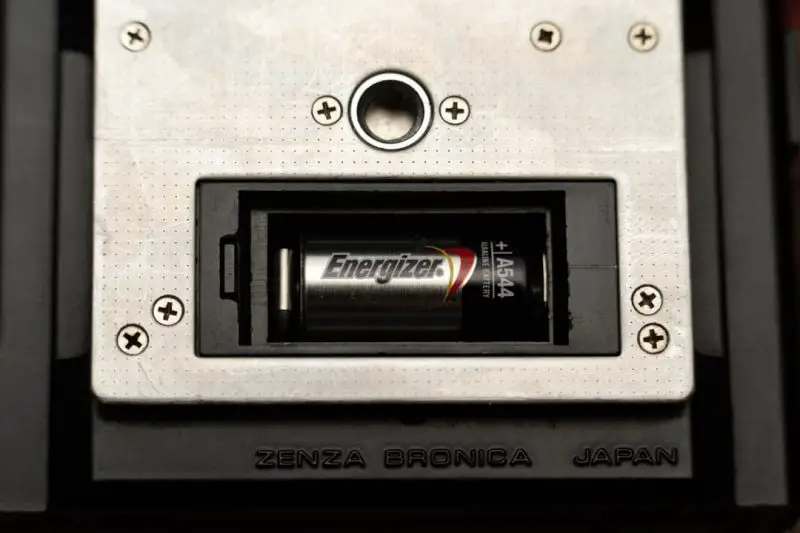
What type of battery does a Bronica ETR, ETRS, or ETRSi use?
When you’re purchasing a new film camera, one of the biggest concerns is always if you’re going to be able to buy a battery that will allow the camera to function. Many cameras relied on battery technology that is no longer manufactured for safety, environmental, or other concerns. Luckily, the battery used in the Zenza Bronica ETR series cameras is likely more popular today than it was when the camera was originally manufactured.
The Zenza Bronica ETR series cameras require a single 4LR44 (a.k.a A544 Energizer, or 28A Duracell) battery to operate the shutter mechanism. Without a battery, the camera can only shoot at 1/500th of a second. So the camera won’t stop working if the battery dies, but it’ll be hard to get the proper exposure. In the ETR, it can be difficult to know when the battery is dead if you’re shooting in daylight, as the shutter isn’t as loud as the mirror, making it difficult to differentiate between the 1/125 and 1/500 of a second. In the ETRS and ETRSi cameras, the battery will also power the viewfinder light meter.
I’ve used both the Energizer A544 batteries and the cheaper, green 4LR44 batteries on Amazon, and I’ve found the Energizer brand batteries to last 10 times as long. Despite costing the same amount,10 of the 4LR44 batteries, won’t last as long as the 3 Energizer batteries. Even if you’re not shooting professionally, having batteries that suddenly die is not ideal. So I absolutely recommend the Energizer versions, like this set on Amazon. At the very least, these batteries are a lot less wasteful.




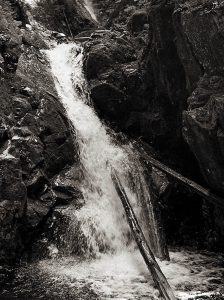



What lenses are the best for the ETR system?
All of the lenses for the Bronica system are sharp, especially when they’re stopped down one or two stops from wide open. The oldest lenses by Bronica are the MC line. Those ones tend to be less sharp, and don’t have as nice of lens coats as newer PE lenses do.
If you buy the Bronica as a kit with a couple of MC lenses, it’s still going to have stellar performance. Purchasing PE lenses will help you create sharper images with less flaring.
The beautiful thing with this system is that very few lenses on this system cost more than $250 USD. Meaning it’s a great system for anyone looking to get high-quality glass on a small budget. The top-of-the-line PE lenses are usually only about $25-$50 more than the early MC lenses, so I absolutely recommend spending a little extra to get superior performance.
| 645 Lens | 135 equivalent |
| 30mm | 20mm |
| 40mm | 24mm |
| 50mm | 30mm |
| 60mm | 35mm |
| 75mm | 45mm |
| 105mm | 65mm |
| 135mm | 85mm |
| 150mm | 95mm |
| 180mm | 110mm |
| 200mm | 125mm |
| 250mm | 155mm |
| 500mm | 310mm |
The camera comes stock with a 75mm f2.8 lens, which is roughly equivalent to a 50mm lens on a 35mm camera. The lens is an absolute dream to use, and has been one of my favorites to keep on this camera at all times. I’ve also loved using the 40mm (24mm on 135) lens, which is perfect for vast landscapes and street photography. The wider lenses are typically short and extremely portable. While the longer, telephoto lenses like the 200mm PE F/4.5 (125mm on 135) can be fairly long.
All of the Bronica lenses are built like tanks. These are lenses that are all metal and glass built, making them good to handle in all conditions. That means even a relatively banged-up lens is still likely to perform well. But if you’re buying on the used market, it’s still always better to pay a little extra for a lens that’s been well taken care of.
What are the drawbacks of the Bronica ETR series?
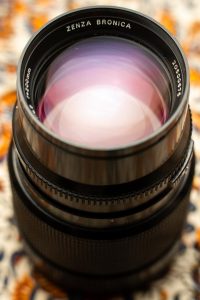
The Bronica ETR system cameras are an incredible value for most photographers out there. Portrait photographers especially will love the leaf shutter mechanism that allows them to use flash at high shutter speeds. And it’s an absolute must for wedding photographers, because of its small size, lightweight, 645 film size, and interchangeable backs.
But this camera doesn’t hold up in every situation. For one, the maximum shutter speed is only 1/500th of a second. Most film photographers have learned to stop down their aperture and keep shooting. But for professionals who need the very best image quality every time, stopping down too far can cause problems with diffraction, which ruins sharpness and contrast along the lens.
This slow shutter speed also means that it’s not a good camera system for anyone shooting sports, action, or wildlife. 1/500 of a second is not fast enough to freeze action, like birds in flight.
For landscape photographers, it’s essential to look for the Bronica ETRSi version. The ETRS and ETR can only keep the shutter open for 8 seconds, which isn’t nearly long enough to blur clouds in the sky. Of course, you can get around that by flipping the double exposure switch and shooting two 8 second exposures, but it’s not going to get as good of results as one continuous minute-long exposure.
And the other issue is the mirror itself. The ETR series camera mirrors shakes the camera hard when the shutter is released. The camera shake from the mirror slapping twice during a single long exposure would be a death sentence for image sharpness. The ETRSi version also has a switch for mirror lockup, which will significantly reduce camera shake in long exposure landscape photography.
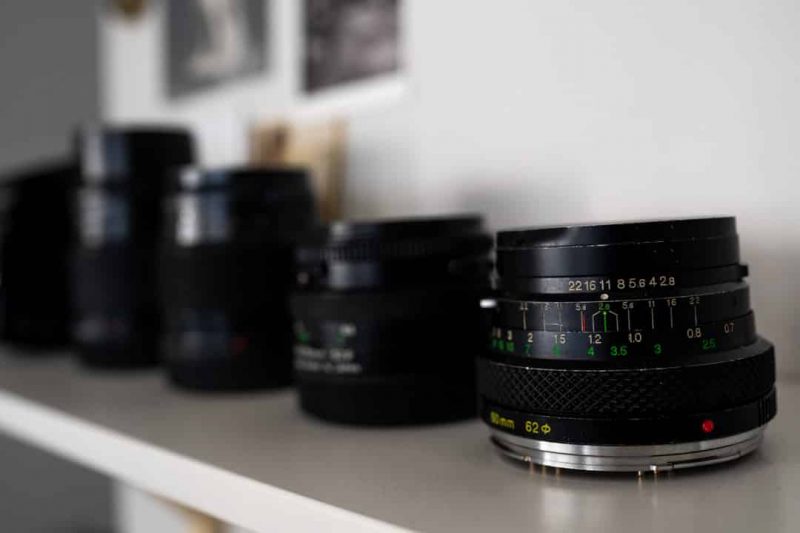
Final verdict: why isn’t the Bronica ETRS more popular?
For portrait, wedding, and landscape photographers, the Bronica ETRS and ETRSi are the best deal in system cameras right now. This camera is an amazing deal with sharp lenses, interchangeable backs, and a brilliant viewfinder. I have had a lot of fun using this camera, and have bought additional lenses to add to my kit.
As to why this camera isn’t more popular, I’m not sure. Most of the drawbacks that exist for this camera are because of the shutter speed only being as fast as 1/500th of a second. But all of the leaf-shutter system cameras from the same time have this same limitation. Even the Mamiya 645n, which was a direct competitor, only managed to get a 1/500th shutter speed with a cloth focal-plane shutter, which only had a flash sync speed at 1/60th.
The Bronica is the perfect camera for photographers looking for a system camera on a budget. And I absolutely recommend picking up an ETRS camera to add to your collection, as this camera is not going to stay this cheap for long.

By Daren
Daren is a journalist and wedding photographer based in Vancouver, B.C. He’s been taking personal and professional photos on film since 2017 and began developing and printing his own photos after wanting more control than what local labs could offer. Discover his newest publications at Soft Grain Books, or check out the print shop.

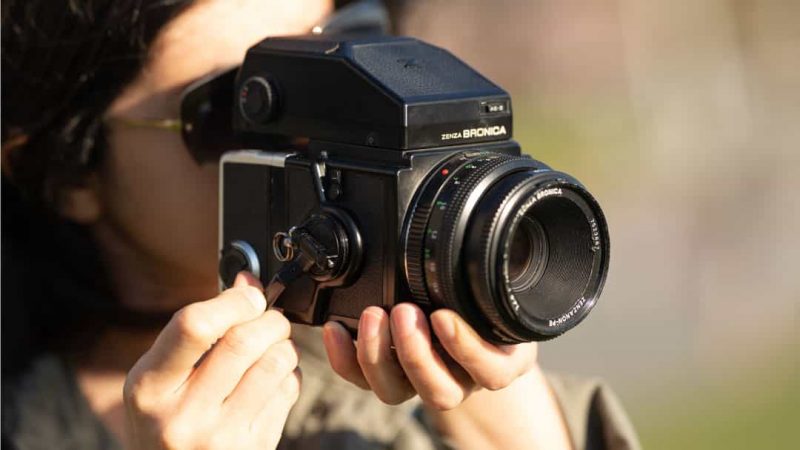
Hey Daren,
Thanks for this very detailed review! It really helped me a lot! Appreciate the effort.
Best regards,
Dan
It’s worth noting that the ETRS does have T (timed) exposure mode, so rather than doing 2x 8 second exposures (like in your example) you can just use T mode and keep the shutter open for as long as you like.
It is a shame that it doesn’t have mirror lockup, but if you have a hat or something dark, you can just cover the lens for a couple of seconds after opening the shutter in T mode while the mirror slap vibrations dissipate, and then just uncover the lens to start your exposure.
Obviously not as convenient as mirror lockup and bulb mode, but if you’re only shooting landscapes some of the time, then it’s totally fine imo.
Where is that T exposure mode? Is it found on the lens, or on the shutter button itself? I have the ETRS in front of me, and I’m not able to find that option. The hat trick is genius, though! Definitely going to have to use that when I have a proper bulb mode.
T mode is a feature found on the lens and is operated by a small switch and locking pin.
I bought an ETR-Si a few years ago when they were incredibly cheap. It is a superb camera to use and delivers really good images. I paid under £200 for the body, 2 film backs, 75mm PE lens and AE II prism finder.
I can recall these cameras as being the wedding photographer’s workhorse back in the 80’s, Every wedding I was at (I was a choirboy with up to 3 weddings every Saturday!) Seemed to have a photographer with a Bronica.
Not cheap in their day, a kit like mine at retail price ran to several thousand pounds.
Apparently the name Bronica was derived from the contraction of “Brownie Camera” or so rumor has it!
Thanks for the article, always find something interesting on your site
I have searched many sites but cannot find a digital back for Bronica etr, Is there such a device available?
Hey Bruce,
There aren’t any digital backs that are purpose build for the Bronica ETR-series. Usually you have to purchase an adaptor plate that the digital back fits onto, then you attach the flash sync on the lens to trigger the digital back. There are a number of them for Bronica ETRS, but they are quite expensiven since they were a bit of a niche object.
Regards,
Daren
Hey Daren, good review
I can’t see a date on this article so don’t know about the “value at this time” comments. This would be good to see somewhere.
When you mention mirror slap I know what you mean. To me a wonderful feeling but yes … shake for those longer exposures. Not that it matters much if it’s once or twice but the mirror on the ETRSi (and I’m pretty sure the ETRS, can’t say for the ETR) only “slaps” once as it then stays up until re-cocked.
Cheers
Paul
Hey Paul,
This article was written mid-2021, and it seems like the camera has maintained its value pretty well since then — it’s surprising to me that it hasn’t jumped as much as other cameras in the same period of time.And that’s true about the shutter slap, it’s lucky that it only affects the shot once. But I do wish that some of the older models had mirror lockup, as that’s an incredibly useful feature for landscape shooters like myself. Not the end of the world, though, since most of us aren’t shooting film to make the sharpest possible images.
Regards,
Daren